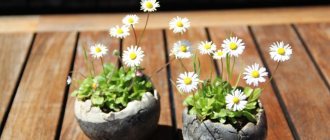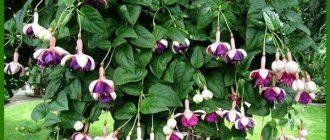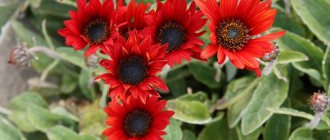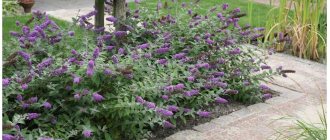Author: Elena N. https://floristics.info/ru/index.php?option=com_contact&view=contact&id=19 Category: Houseplants Published: February 27, 2019Last edits: January 11, 2021
- When to plant
- Growing conditions
- Bacopa caroliniana
plant (lat. Bacopa) belongs to the genus of the Plantain family, which includes more than 100 species of aquatic, water-loving, succulent creeping rhizomatous perennials. Bacopa is native to South America and the Canary Islands. In nature, bacopa grows on the marshy shores of reservoirs in the tropics and subtropics of Asia, Australia, America and Africa. The second name for bacopa is sutera. The bacopa flower has been in cultivation since 1993. It is also grown in temperate climates, using it as an ampel and as a ground cover plant.
Planting and caring for bacopa
- Flowering: abundant, gradually weakening, but then growing again.
- Planting: sowing seeds for seedlings - in March, planting seedlings in open ground or in hanging structures - in mid-May.
- Lighting: bright sun or partial shade in areas protected from strong winds.
- Soil: drained, humus-rich fertile soils with a slightly acidic reaction.
- Watering: frequent and plentiful, especially during drought.
- Feeding: Only young plants need feeding from spring to September. Complex mineral fertilizers are used in turn with organic ones.
- Pruning and pinching: for better tillering, shoots are pinched from time to time, and lashes that are too long are shortened. The plant is pruned when flowering becomes scarce and the lower part of the shoots becomes woody.
- Reproduction: by seeds, from January to April - by apical cuttings.
- Pests: at home - whiteflies, aphids and spider mites.
- Diseases: gray rot, sooty or mold fungus.
Read more about growing bacopa below.
Diseases and pests
Among the diseases of Bacopa, the most common are gray mold and fungus. They arise due to several flower bushes planted too densely or waterlogging of the soil.
Yes, Bacopa loves moisture very much, but if it does not evaporate and sunlight does not reach the soil due to dense greenery, fungi and gray rot appear. You should thin out the thick stems to open up the soil, and don’t forget to loosen it. It won’t hurt to treat the shoots with a fungicide.
Pests occur most often during indoor wintering, when the humidity is low and the temperature is above 15 degrees. There is enough heat and dry air for the appearance of sucking pests - aphids, whiteflies and spider mites. If a plant overwinters in not very suitable temperature conditions, it is important to inspect it for timely detection of pests and control them. Parasites can be destroyed by 2-3 acaricide treatment procedures.
Bacopa is a wonderful decoration. In the garden it will create a flowering carpet; on balconies or loggias it will act as a hanging carpet - an avalanche of long flowering vines. Bacopa, which does not require much effort to care for and grow, will delight its owner with greenery and color until the cold weather.
Botanical description
The stems of bacopa are thin, creeping, creeping or lodging, reaching a length of 60 cm and growing greatly in width. The leaves are small, broadly elliptic or ovate, green or olive-green in color, linear, with a serrated edge. Ampelous bacopa blooms with axillary bell-shaped or tubular flowers (depending on the type and variety), small or large, simple or double, white, pink, lilac, blue, light blue, red, violet or lilac. Bacopa blooms for a long time and occurs in waves: after an abundant first wave, the formation of flowers dies out, and after a while it intensively resumes. The lifespan of the plant is short, but it reproduces easily. Cultivation of ampelous bacopa is carried out both in the garden and at home.
Wintering
Bacopa ampelous - growing and care at home
For proper wintering, all shoots of the plant are removed almost to the root. A bush is dug up from the garden and transplanted into a pot (bacopa will not tolerate frost). Place the pot in a room where the temperature will constantly be no higher than 10 degrees. Watering is reduced to a minimum; it is advisable that the earthen ball dry well after a warm period before the next watering. Any fertilizing, increased temperature, and abundant light are excluded.
Bacopa is a perennial bush, so with proper winter care it can live wonderfully in a pot for several years
Such wintering will preserve the plant as much as possible and in the spring after awakening it can continue its growth and flowering in the garden or on the balcony.
If the temperature is not suitable for sleep, the plant loses its decorative effect, the shoots stretch into thin threads, the leaves fade and thin out. In this situation, you can take cuttings from last year’s bush and get many new healthy plants ready for planting in the spring.
Growing bacopa from seeds
How to sow seeds
For the primary cultivation of bacopa, you will have to resort to the seed propagation method. Growing bacopa from seeds does not involve any particular difficulties, and purchasing high-quality seed material in the store is not a problem. When to sow bacopa for seedlings? Sowing is carried out in March in a peat substrate sterilized for 4 hours in the oven at a temperature of 100 ºC, which, after cooling, is placed in a container with transparent walls. There is no need to bury the bacopa seeds; just press them to the surface of a moistened substrate and cover them with film or glass. Bacopa germinates from seeds in the light, at a temperature not lower than 20 ºC. Shoots can appear in 10-14 days, and the full germination period can last 3-4 weeks.
Seedling care
Caring for bacopa during the seedling period is simple. Once seedlings begin to emerge, it is important not to allow the substrate to dry out. Remember to carefully loosen the soil around the seedlings. At the stage of development of seedlings with three true leaves, the first picking of bacopa is carried out - transplanting the seedlings into separate peat pots with a diameter of 5 cm. After the seedlings have settled in the new place, they are fed with complex mineral fertilizer in half the dose recommended by the manufacturers. The optimal temperature for growing bacopa seedlings is 22-26 ºC.
- Planting and caring for petunia in the garden
If you are going to plant seedlings in the garden, then most likely the bacopa seedlings will require a second picking - transplanting into larger pots, which, for the stability of the seedlings, is carried out with the stem buried by one node. A week after the second picking, when the bacopa seedlings have taken root, they are fed with complete mineral fertilizer with a predominance of phosphorus and nitrogen, after which the temperature in the room during the day is maintained within 15-24 ºC, and at night – about 13-15 ºC.
If you grow bacopa as a houseplant, then there is no need to carry out a second picking - the seedlings are immediately transplanted into a pot or basket.
What difficulties may arise
For those who love Bacopa very much, the biggest difficulty is encountering aphids, or white-winged midges. In order to cope with pests, special means are used.
The plant is very unpretentious, but if you do not care for it correctly, you will have some difficulties with the plant. If the plant changes the color of the leaves, it will not bloom, and very elongated cellars will indicate that the plant does not have enough light.
And if the leaves wilt and are buried, then this indicates that you forget to water it, or it suffers from extreme heat. But all this can be fixed, you just need to take the flower and move it to another place, but before that you need to learn the rules of caring for the plant.
Planting bacopa in the garden
When to plant
Bacopa is planted in open ground as soon as the threat of return frosts disappears, that is, approximately in mid-May. But first, the seedlings must undergo hardening: they are taken out into the open air every day, gradually increasing the duration of the sessions until the seedlings can spend the whole day in the yard.
How to plant
Bacopa grows best in sunny areas protected from the wind. You can plant it in partial shade, however, the less sunlight the plant receives, the fewer flowers there will be. In the shade, bacopa generally loses its decorative properties - its shoots become elongated and few flowers are produced.
Bacopa is undemanding in terms of soil composition, but it is best suited to well-drained, fertile, humus-rich soils with a slightly acidic reaction. When planting in open ground, the distance between seedlings, depending on the variety, is kept within 10-25 cm - the taller the plant, the more space it will need.
Bacopa care in the garden
Growing bacopa in the garden involves performing such usual gardener activities as watering, weeding, loosening the soil, fertilizing, pinching and pruning, as well as protection from diseases and pests. There is no need to remove faded flowers - bacopa can clean itself. The plant needs to be watered frequently and abundantly, especially in dry, hot summers. After watering, you should lightly loosen the soil, being careful not to damage the surface root system of the plant. Weeds also need to be removed carefully, and it is better to do this manually.
- Homemade medicinal plants
As for fertilizing, only young plants need them. Fertilizers are applied from spring to September, but as winter approaches, fertilizing is stopped. Fertilize bacopa with complex mineral solutions, alternating them with organic matter - solutions of bird droppings or mullein.
Rules of agricultural technology
To turn your yard or garden into a piece of paradise, you need to know the features of planting and caring for bacopa. The rules of agricultural technology are simple and easy to master for amateurs and beginners.
Place
The choice of location is a decisive factor for successful cultivation. It is important to choose a site with good lighting, because bright sun is necessary for vigorous bud formation throughout the summer. In the shaded area, rapid growth will be observed, the shoots will begin to grow very quickly, but the flowering will be sparse and short-lived. If the bush is planted as a ground cover for a shady place, then it will cope with its function perfectly. Good development is possible on a site without drafts and winds.
The soil
The plant is successfully grown in different types of soil, but for best results the following indicators are necessary:
- nutritious soil with a large amount of humic substances;
- permeability for good air exchange;
- weakly acidic reaction of the substrate.
If the soil is alkaline, it is recommended to add potassium sulfate to it before planting.
For growing in a hanging pot or ampel pot, you can buy soil for azaleas, hydrangeas or conifers, or you can prepare it yourself. For this you will need:
- old cow dung - 2 parts;
- turf soil - 1 part;
- coarse river sand – 1 part;
- black peat – 1 part.
The container must have drainage holes and a layer of expanded clay for normal drainage of water after watering.
Landing
Seedlings are planted in a permanent place in open ground when the threat of night frosts disappears. In the middle zone, this time begins in the last ten days of May, and in the southern regions - at the end of April.
When mass planting, it is necessary to maintain a distance between neighboring seedlings, otherwise they will compete with each other during cultivation, and stronger specimens will suppress the rest. For short people, the interval is 10 cm, and for tall people, 25 cm.
During transplantation, it is best to follow the transshipment technique, that is, try not to destroy the earth ball and move the plant so that the roots are not damaged. Damage to the root system is the most common cause of failure during planting.
Watering
Like all succulents, bacopa can tolerate dry periods for some time, but this has a bad effect on its decorative properties. If there has been no rain for a long time, and the weather is hot, you will need to water the plants, and then loosen the soil. In this case, you should be careful, since the root system of the sutera is located just under the surface, and it is easy to damage it with a hoe. Loosening will allow you to break up the dry crust and ensure air exchange in the soil. It is advisable to carry out weeding not with an ordinary garden hoe, but with a small tool for indoor flowers.
Plants in closed containers need active watering. In summer you will need to moisturize them daily, and in the hottest weeks - in the morning and evening. It is advisable to do this before the sun rises high and after sunset, so that burns do not appear at the site of the drops.
Feeding
2 weeks after transplantation, you can start fertilizing with complexes for decorative foliage crops at ½ dosage. This procedure is carried out once a week. As soon as the first buds appear, the product is changed to fertilizer for abundantly flowering ones, for example, for petunias and surfinias. During abundant flowering, feed once a week until autumn. If the flower is planned to be sent for the winter, the application of mineral complexes is stopped at the end of August.
Instead of synthetic products, weak solutions of mullein or chicken droppings are often used.
Trimming
To prevent bacopa shoots from becoming bare, periodic pruning is necessary. During this process, adult branches are shortened by ½. The best time for this is the next decrease in flowering intensity. First of all, those shoots that have begun to become lignified at the base are shortened. After each pruning, it is necessary to fertilize to quickly restore the crown.
There is no need to remove faded flowers from the bush; sutera is capable of self-cleaning, so it will not look untidy. Also, this will not affect the intensity of bud formation.
If you plan to send the succulent for the winter, then prune it before placing it in a cool place.
Wintering
In order not to replant the sutera next year, you can send it to a cool room for the cold months after severe pruning. Once a month or a month and a half it will be necessary to water, but waterlogging should not be allowed. Comfortable temperature for this period is +5…+10°С. Fertilizers are not applied until spring.
Bacopa care at home
Growing conditions
The conditions for growing bacopa in an apartment are not much different from those in the garden. How to grow bacopa indoors? The plant is planted in a substrate with approximately the following composition: humus, sand, garden soil and peat in a ratio of 2:2:1:1. The soil for ampelous bacopa should prevent waterlogging, since the fragile roots of the plant are prone to rotting, and that is why a thick layer of drainage material must be placed in the pot. Homemade bacopa, like garden bacopa, should be watered frequently and abundantly, but avoiding, however, long-term and chronic waterlogging of the soil, since this is much more dangerous than rare and insufficient moisture. After watering, the soil in the pots must be carefully loosened. Once every 10-14 days, liquid mineral fertilizer for flowering plants is added to the irrigation water so that the bacopa greens are always juicy and bright, and the flowering is abundant. The fertilizer solution is poured at the root, trying not to get on the leaves of the plant.
Accommodation
Bacopa at home, just like in the garden, requires good lighting and some direct sunlight every day. It grows well in partial shade, but if you place it away from the light, you may not wait for flowering. Since the plant normally tolerates temperature changes and even frosts down to -5 ºC, bacopa in a flower pot can decorate a balcony, terrace, veranda or loggia from spring to late autumn.
Trimming
In order for bacopa to bush well, the ends of its shoots are pinched from time to time, and if the lashes of the plant become too long, they are cut off. The apical cuttings remaining after pruning are used for propagation. Bacopa is also pruned when the lower part of its shoots begins to become lignified and flowering becomes scarce. In this case, the shoots are shortened by a third of their length, and it is better to do this pruning in the fall.
Pests and diseases
If care is improper or the growing conditions are not met, bacopa can be affected by gray rot, sooty or mold fungus, especially if the planting is too dense. If bacopa is damaged by fungi, its crown must be thinned out, and then the plant must be treated two or three times with a fungicidal solution at intervals of two weeks.
Among the pests, bacopa is affected by whiteflies, aphids and spider mites. All these insects are sucking, that is, they feed on the cell sap of bacopa, so they can be destroyed with acaricidal preparations in two or three stages.
Bacopa propagation
In addition to the seed propagation method, cuttings are used for propagating bacopa, for which apical cuttings about 10 cm long are used. They take root easily and quickly in moist, loose soil consisting of vermiculite and sand in equal parts. The cutting is buried 5 mm so that one node is underground - it will give new roots. The other node should remain above the surface of the soil - shoots will develop from it. The roots grow within 2-3 weeks, but to speed up root formation, it is advisable to treat the cut of the cutting with a growth stimulant or phytohormones. To create a greenhouse effect, the cuttings planted in the ground are covered with a transparent cap, and then placed in a well-lit place, protected from direct sunlight. During rooting, the soil should be slightly moist. When the cutting begins to form shoots, pinch it to encourage tillering.
- Hyacinths - cultivation
The best time for cuttings is from January to April - at this time, adult bushes are divided into cuttings. It is also good to root cuttings at the end of summer, when there is a lot of planting material left after pruning. Cuttings of white bacopa take root best; other types of plants are more capricious and require the use of drugs that stimulate root growth.
Using plants in landscape design
The most common use of the plant is as a solo element. It is planted in hanging pots or baskets and decorated with the surrounding area as a ground cover crop.
The flower also looks good in a flowerbed, both solo and in tandem. Nasturtium, Fuchsia, Lobelia, Petunia will be excellent companions for culture.
Perennial bacopa in winter
In the open ground or in the garden, perennial bacopa will not survive the winter, so with the onset of cold weather it must be brought into a room where there are no drafts, high air humidity and the temperature is maintained at 12-15 ºC. In winter, watering bacopa should be infrequent, since its growth stops. The wintering plant also does not need fertilizing.
Many gardeners do not plant perennial bacopa as a whole bush in the spring, since it still loses its decorative value over the winter. They take the overwintered plant into cuttings.
After pruning, homemade bacopa is also placed in cool conditions until spring. This could be a glazed balcony, loggia or unheated veranda or room.
Types and varieties
In addition to the types and varieties of bacopa existing in nature, many varieties and hybrids have recently appeared, bred by breeders. The most popular of them in amateur gardening are:
Bacopa caroliniana
The plant is native to the eastern United States, reaching a height of 30 cm. It has thick, erect stems, planted in pairs with cross-shaped oval leaves, light green in the shade, and copper-red in bright sun. Small bright blue flowers open at the ends of the stems. This is aquarium bacopa - it is often grown in water under glass. In gardens, Carolina bacopa is planted along the banks of reservoirs, artificial or natural, or directly in them. The depth of the water in this case should be at least 30-35 cm;
Australian bacopa (Bacopa australis)
A low-growing plant with thin stems, growing in the water column. The shoots of Bacopa australis are covered with light green oval or rounded opposite leaves up to 18 mm long. The light blue flowers of the plant open on the above-water part of the shoots;
Bacopa monnieri (Bacopa monnieri)
Succulent with creeping stems, oblong sessile leaves from 8 to 20 mm long, entire or sparsely toothed and rounded at the apex. The flowers of this plant are axillary, with a blue, white or purple corolla up to 1 cm long;
Bacopa cordata
Herbaceous perennial up to 15 cm high with small or medium-sized green leaves;
Bacopa diffuses
Or beautiful (Bacopa speciosa) - a perennial plant from South Africa and the Canary Islands, originally with snow-white flowers that do not lose their decorative effect even during periods of prolonged rain. This plant is characterized by long flowering and the ability to self-clean - shed faded flowers.
The most famous varieties of spreading bacopa are:
- Snowflake is a variety of ampelous bacopa with an abundance of large white flowers;
- Cabana – large-flowered bacopa;
- Olympic Gold is a hybrid plant with shoots up to 60 cm long, white flowers and golden-green small leaves;
- Skopia Double Blue is a ground cover plant with large purple-pink flowers and bright green leaves;
- Blizzard is a plant with many small flowers;
- Rosea is a variety with pink flowers;
- Pink Domino is a plant with purple flowers;
- Taibun Blue is a variety of bacopa that blooms profusely with purple flowers.
In addition to those described, popular varieties of bacopa are Giant Cloud, Blue Showers, African Sunset and others.











